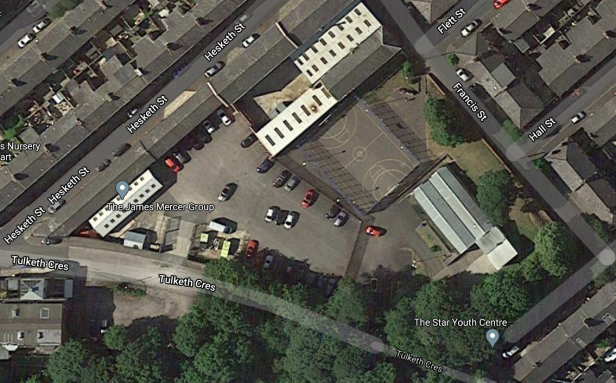Tulketh Castle, or Preston Castle as it is sometimes known, is a rather enigmatic fortress. Although we know there was a castle at Tulketh, and are reasonably confident as to where it was sited, it is hard to pin down much about its history. It was most likely a Norman castle, built soon after their invasion and used to subdue the local Saxons. It was probably reused during ‘The Anarchy’, the time of civil war between King Stephen and Princess Matilda, daughter of King Henry I.

As a Norman castle, it would have had the traditional motte and bailey form. It may well have been built as a ‘twin’ castle to the one at Penwortham. This stood on the opposite bank of the River Ribble and its motte remains in place today. Tulketh Castle would have been used to control the area north of the Ribble known as Amounderness (present day Wyre and Fylde). Penwortham Castle would have controlled the area south of the Ribble. Both castles could be used to monitor the wide river and any boats coming up and down it.
In 1123, the castle was given to Stephen of Blois by King Henry I as part of the Honour of Lancaster. By this time it is thought that the castle was no longer in use. Stephen offered land in Tulketh to French Savignaic monks, so that they might form their first monastery in England. It’s known that the monks moved into some pre-existing buildings, and most historical sources state that this was most probably the disused Tulketh Castle. Here they established Tulketh Abbey. The monks stayed for a mere three years before they relocated to the Furness peninsula to create Furness Abbey.
When Henry I died, Stephen claimed the throne, staking his claim on being the king’s nephew. He was opposed by Henry’s daughter, Matilda, who believed that she was the legitimate heir. This dispute led to the first English Civil War (1135- 1153). Interestingly, King David of Scotland held land in Lancashire north of the Ribble during this time. Whether this was by agreement with Stephen or whether he had annexed the area is not clear. We do know that he came into possession of Tulketh Castle during the years 1140-1142. The Cartulary of Shrewsbury Abbey states that King David of Scotland issued a charter to the monks of Shrewsbury when he was at his “new castle of Thulchet”. It is probable that the castle was refortified at this time.
Where Was the Castle?
In the 1770s, a Catholic Priest named Father West identified a mound and a ditch south-west of Tulketh Hall as being the earthworks of Tulketh Castle. This would have been the motte of the castle with its defensive trench around it. Another source states that the mound was 300 feet from the hall and was circular and conical. It measured 125 feet in diameter at the base.

The 1849 OS map clearly shows the mound on the bottom right hand side of the above map. The castle motte had probably been protected for centuries by lying within the grounds of Tulketh Hall. Unfortunately, in 1845, the owner Peter Hesketh-Fleetwood was forced to sell the hall’s estates when his construction of the town of Fleetwood almost bankrupted him. This included the land immediately around the hall itself. It was bought by John Abel Smith MP, a Preston banker, and just ten years later, in 1855, the motte was flattened.

Visiting the Site Today
As stated above, the castle motte was found within the grounds of Tulketh Hall. The remnant of this is a triangular shape bounded by the modern roads of Hesketh Street, Tulketh Crescent and Francis Street. We know that the mound of the castle was 300 feet (or 90 metres) from the hall. Although the hall was demolished in 1959, records show that St Thomas’s Industrial School buildings were constructed alongside it. Walk up the steps on Francis Street and stand with the Industrial School buildings behind you (see photograph below). Look south towards the city of Preston. You can see that the land falls rapidly away, showing that the site had a commanding view which, before the houses were built, would have looked down towards the Ribble. (Approaching the site from the Aqueduct Street area requires quite a long climb to reach it). Walk from Francis Street past Star Youth Centre to Tulketh Crescent to gain further views of the site, noting the steepness.

For more on Tulketh Abbey, see our page here.
For an extensive article on the history of Tulketh Hall, see the Preston History website here.
For the fascinating history of St Thomas Industrial School, see the Children’s Homes website here.
Access
Park on Francis Street. Ascend the steps to look out and see the view down to the city, with the spire of St Walburge clearly visible. The James Mercer Group building (former Industrial School) and Star Youth Centre form the boundary of the site, the outside of which you can walk around.
Nearby
Penwortham’s Lost Medieval Monastery
Lost Leper Hospital of St Mary Magdalene
References
Lancashire Castles and Towers, Leslie Irving Gibson (1977), Dalesman Books
Buckton Castle, Brian Grimsditch, Michael Nevell and Richard Nevell
A History of Furness Abbey, Alice Leach (1987), Furness Heritage Press
Preston History website. The page on Tulketh Hall. This page was invaluable for tracking down some of the more difficult to find references. prestonhistory.com/subjects/the-story-of-tulketh-and-tulketh-hall/
pastscape.org.uk/hob.aspx?hob_id=42722
maps.nls.uk/view/102343946
creativecommons.org/licenses/by-nc-sa/4.0/
Comments are closed.